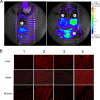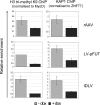Regulation of episomal gene expression by KRAB/KAP1-mediated histone modifications
- PMID: 19279087
- PMCID: PMC2681943
- DOI: 10.1128/JVI.00001-09
Regulation of episomal gene expression by KRAB/KAP1-mediated histone modifications
Abstract
KAP1 is an essential cofactor of KRAB zinc finger proteins, a family of vertebrate-specific epigenetic repressors of largely unknown functions encoded in the hundreds by the mouse and human genomes. So far, KRAB/KAP1-mediated gene regulation has been studied within the environment of chromosomal DNA. Here we demonstrate that KRAB/KAP1 regulation is fully functional within the context of episomal DNA, such as adeno-associated viral and nonintegrated lentiviral vectors, and is correlated with histone modifications typically associated with this epigenetic regulator.
Figures





Similar articles
-
KRAB-zinc finger proteins and KAP1 can mediate long-range transcriptional repression through heterochromatin spreading.PLoS Genet. 2010 Mar 5;6(3):e1000869. doi: 10.1371/journal.pgen.1000869. PLoS Genet. 2010. PMID: 20221260 Free PMC article.
-
The KAP1 corepressor functions to coordinate the assembly of de novo HP1-demarcated microenvironments of heterochromatin required for KRAB zinc finger protein-mediated transcriptional repression.Mol Cell Biol. 2006 Nov;26(22):8623-38. doi: 10.1128/MCB.00487-06. Epub 2006 Sep 5. Mol Cell Biol. 2006. PMID: 16954381 Free PMC article.
-
A gene-rich, transcriptionally active environment and the pre-deposition of repressive marks are predictive of susceptibility to KRAB/KAP1-mediated silencing.BMC Genomics. 2011 Jul 26;12:378. doi: 10.1186/1471-2164-12-378. BMC Genomics. 2011. PMID: 21791101 Free PMC article.
-
KAP1/TRIM28: Transcriptional Activator and/or Repressor of Viral and Cellular Programs?Front Cell Infect Microbiol. 2022 Feb 23;12:834636. doi: 10.3389/fcimb.2022.834636. eCollection 2022. Front Cell Infect Microbiol. 2022. PMID: 35281453 Free PMC article. Review.
-
KRAB zinc finger proteins.Development. 2017 Aug 1;144(15):2719-2729. doi: 10.1242/dev.132605. Development. 2017. PMID: 28765213 Free PMC article. Review.
Cited by
-
Kaposi's sarcoma-associated herpesvirus-encoded LANA interacts with host KAP1 to facilitate establishment of viral latency.J Virol. 2014 Jul;88(13):7331-44. doi: 10.1128/JVI.00596-14. Epub 2014 Apr 16. J Virol. 2014. PMID: 24741090 Free PMC article.
-
The Krüppel-associated box repressor domain can induce reversible heterochromatization of a mouse locus in vivo.J Biol Chem. 2012 Jul 20;287(30):25361-9. doi: 10.1074/jbc.M112.350884. Epub 2012 May 17. J Biol Chem. 2012. PMID: 22605343 Free PMC article.
-
The complexity of TRIM28 contribution to cancer.J Biomed Sci. 2017 Aug 29;24(1):63. doi: 10.1186/s12929-017-0374-4. J Biomed Sci. 2017. PMID: 28851455 Free PMC article. Review.
-
Spotting the enemy within: Targeted silencing of foreign DNA in mammalian genomes by the Krüppel-associated box zinc finger protein family.Mob DNA. 2015 Oct 2;6:17. doi: 10.1186/s13100-015-0050-8. eCollection 2015. Mob DNA. 2015. PMID: 26435754 Free PMC article. Review.
-
Gypsy and the birth of the SCAN domain.J Virol. 2011 Nov;85(22):12043-52. doi: 10.1128/JVI.00867-11. Epub 2011 Aug 24. J Virol. 2011. PMID: 21865395 Free PMC article.
References
-
- Ayyanathan, K., M. S. Lechner, P. Bell, G. G. Maul, D. C. Schultz, Y. Yamada, K. Tanaka, K. Torigoe, and F. J. Rauscher III. 2003. Regulated recruitment of HP1 to a euchromatic gene induces mitotically heritable, epigenetic gene silencing: a mammalian cell culture model of gene variegation. Genes Dev. 171855-1869. - PMC - PubMed
-
- Bornkamm, G. W., C. Berens, C. Kuklik-Roos, J. M. Bechet, G. Laux, J. Bachl, M. Korndoerfer, M. Schlee, M. Holzel, A. Malamoussi, R. D. Chapman, F. Nimmerjahn, J. Mautner, W. Hillen, H. Bujard, and J. Feuillard. 2005. Stringent doxycycline-dependent control of gene activities using an episomal one-vector system. Nucleic Acids Res. 33e137. - PMC - PubMed
-
- Cudre-Mauroux, C., T. Occhiodoro, S. Konig, P. Salmon, L. Bernheim, and D. Trono. 2003. Lentivector-mediated transfer of Bmi-1 and telomerase in muscle satellite cells yields a Duchenne myoblast cell line with long-term genotypic and phenotypic stability. Hum. Gene Ther. 141525-1533. - PubMed
-
- Friedman, J. R., W. J. Fredericks, D. E. Jensen, D. W. Speicher, X. P. Huang, E. G. Neilson, and F. J. Rauscher III. 1996. KAP-1, a novel corepressor for the highly conserved KRAB repression domain. Genes Dev. 102067-2078. - PubMed
MeSH terms
Substances
LinkOut - more resources
Full Text Sources
Other Literature Sources
Miscellaneous

